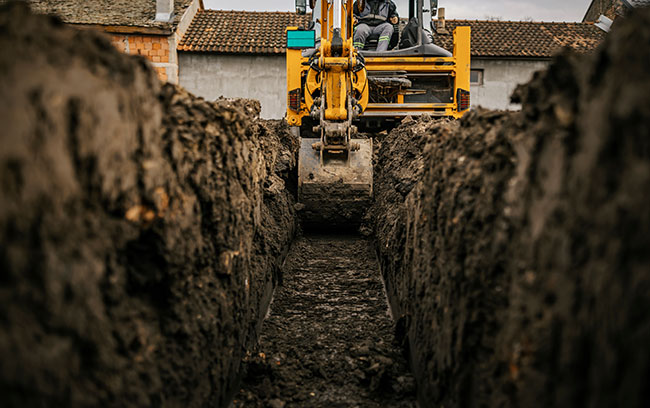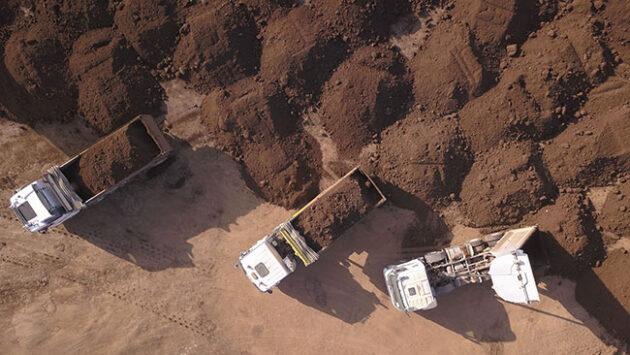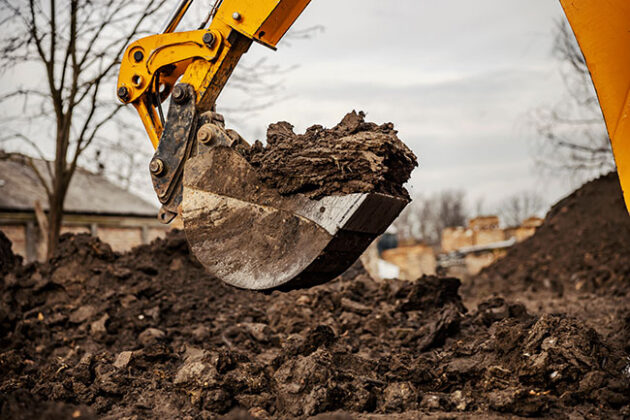
Features
Aggregates
Columns
Education
Managing Ontario’s excess soils
An overview and a guide
April 14, 2023 By Robert Kennaley
 Photo: © dusanpetkovic1/ Adobe Stock
Photo: © dusanpetkovic1/ Adobe Stock The first phase of Ontario’s new regulation for On-Site and Excess Soil Management, Regulation 406/19, (passed under Ontario’s Environmental Protection Act) came into force on January 1, 2021. Intended to ensure that excavated soils are treated as a resource to be beneficially re-used wherever possible, unless a section 2 exemption applies, the Regulation applies to all “projects” (broadly to include among other things “any form of development or site alteration”), virtually any type of construction and the removal of liquid solid from a “surface body of water”. Further, any soil or soil mixed with rock which is removed from a project area is defined as “excess soil” and is deemed to be a “waste” and which cannot be reused, stored, transported or disposed of except as specified. The Regulation then sets out a complete code for the excavation and movement of excess soils between properties, imposing requirements for soil testing, transportation, temporary storage at processing sites or transfer facilities, the interim clean-up of soils, data tracking, re-use (on-site or at other sites) and disposal at a landfill or dump.
We have written on the structure and technical requirements of the Regulation elsewhere (see our website or search canlii.org in that regard). Accordingly, our focus in this article will be on how the risks associated with the Regulation can and should be assessed and managed in contracts and subcontracts. We have also prepared a two-page flow-chart guide, available on our website (www.kennaley.ca), which can be used as a filter to access the Regulation’s application and associated risks, from the project-planning stage through to the final placement of excess soils. If downloaded in PDF format, that guide includes hyper-links to the various applicable statutes, sections, authorities and resources referenced. This article can be read in tandem with the guide to elaborate on the points made. We hope it will be helpful. The starting point for risk assessment lies in determining whether or not the Regulation applies. Section 2 provides that it does not apply in respect of excavations subject to O.Reg 347, certain pit or quarry operations, topsoil excavations permitted under the Aggregate Resources Act, certain peat extraction operations and “the final placement of excess soil on the bed of a surface water body”.
More significantly, perhaps, the Regulation only applies to soil (or soil mixed with rock) to be removed from a “project area” (being a “property or adjoining property on which the project is carried out”). Project planners and contractors might accordingly consider options to reduce or eliminate the need to remove soils, including alternative excavation methods (such as hyrdovac and trenching) or design options. Reuse of soils on site, however, will remain subject to other applicable legislation including the Building Code Act, the Environmental Protection Act (inc. O.Reg. 347), the Planning Act, the Aggregates Resources Act, local municipal site-alteration by-laws and other site-specific instruments.
Particular care should be taken in relation to site alteration by-laws. This, because the authority of municipalities to pass such a by-law goes well beyond the scope of O.Reg 406/19: they can prohibit or regulate the placement of fill, the removal of topsoil, the altering of grades and the rehabilitation of a project site, (even where O.Reg. 406/19 would otherwise allow the activity). Furthermore, the terms and conditions of site alteration by-laws can vary widely across municipalities and many have been recently updated to (in part) manage the issues associated with O.Reg 406/19.
Accordingly, site alteration by-laws might impose much more restrictive requirements on the reuse or placement of materials on a project or disposal site. Significantly, for example, they might limit the options available to retain soils at the project site (through berms, etc.) or limit or negate the placement of any materials at a potential storage, processing or re-use site. In addition, however, site alteration by-laws and other municipally passed site specific instruments can, in some cases, lessen the impact of O.Reg. 406/19 by allowing for the placement of large quantities, or lesser quality materials, then would be required by the Soil Standards established under the Regulation. Section s.4 of the Regulation more particularly establishes tables that essentially provide that the site by-laws or instruments will trump O. Reg. 406/19 as regards the quantity and quality of soils that may be placed at a re-use site.
While s. 2 provides exemptions to the entirety of the Regulation, other exemptions apply to various aspects of the Regulation. The most significant of these arise under s. 8(2), in relation to the requirement that a Notice be filed with the Excess Soil Registry in accordance with s. 8(1) of the Regulation. To recall, the filing of the Notice kickstarts the intensive assessment, reporting, materials tracking and record keeping requirements of O.Reg. 406/19. Pursuant to s. 8(2), however, no Notice needs to be filed where the circumstances set out in Schedule 2 of the Regulation apply or where a project leader entered into a contract for the management of excess soil from the project prior to January 1, 2022.

Under the new regulation, any soil or soil mixed with rock which is removed from a project area is defined as “excess soil” and is deemed to be a “waste” and which cannot be reused, stored, transported or disposed of except as specified. Photo: © MagioreStockStudio/Adobe Stock.
Compliance with O.Reg. 406/19 can be expensive and time consuming. Accordingly, where a s. 2 or s. 8(2) exemption applies, significant time and money can be saved. In addition, where a site alteration by-law or other site specific instrument applies, the applicable soil related obligations might be significantly increased, or decreased, depending on the terms and requirements of same. A failure to identify a s. 2 or s. 8(2) exemption or applicable by-law or instrument can therefore lead to delays, increased costs and claims. Important questions accordingly need to be addressed at the tender preparation, bidding and contracting stages: Who is responsible to determine if exemptions or site-specific instruments apply and when will the determination be made? Prudence dictates that the responsibility for, and timing of, these determinations be understood and set out in the Contract Documents. Prudence also dictates that, if an exemption is known to apply, this also be set out in the Contract Documents.
The importance of any possible s. 8(2) exemption is highlighted when we consider the significance of section s. 8(1)’s Notice filing requirement. Where no s. 2 or s. 8(2) exemption applies, and where excess soils is to be removed from a project area, s. 8(1) requires that the “project leader” file a Notice containing the information set out in Schedule 1 with the Excess Soil Registry. This information includes the project leader’s declaration that (among other things) she/he/it will “develop and apply all necessary procedures to ensure that all necessary steps are taken to ensure that this Regulation is complied with” and “ensure that excess soil from the project area will be disposed of in compliance with this Regulation”.
The “project leader” who files signs the declaration must accordingly be prepared to assume an enormous amount of responsibility. There can, however, be more than 1 project leader, which is defined as “the person or persons who are ultimately responsible for making decisions relating to the planning and implementation of the project.” Determining who will file the Notice and sign the declaration to take on the responsibility to ensure the Regulation is followed is accordingly critical to sound planning and cost control. No-one wants to find out others expected them to take on the responsibilities, at their cost. Prudence accordingly dictates that the determination of who must file the Notice and make the declaration be made early and set out in the Contract Documents to avoid confusion and delay.
The project leader who makes the declaration in the Notice must ensure that all necessary assessments, testing and reporting is undertaken by a qualified person. Subject to certain exceptions (set out at s.11(2), 12(3) and s.14), a qualified person (as defined under O.Reg 153/04) must be retained to prepare and/or oversee and update the following, in accordance with the Rules For Soil Management and Excess Soil Quality Standards, (the “Soil Rules”): a s. 11 assessment of past uses of the project area, (unless a phase one ESA under O.Reg 153/04 has already been prepared), a s. 12 sampling and analysis plan, a s. 13 excess soil destination report and a s.15 report of any “immediate conditions” encountered.
Those responsible for planning should be aware that the requisite assessment, sampling, analysis and technical reporting will take time and money. Practically, much of it will have to occur pre-excavation. In addition, there may (and will most likely be) a shortage of available QPs to accommodate the new requirements on particular projects, given the increased workloads they will face in that regard. Prudence accordingly dictates that QP(s) are lined up and retained under contracts early, and that sufficient time and money for the requisite steps is allowed for.
As discussed elsewhere, and subject to limited exceptions, excess soils must be assessed and processed (if necessary), so that they will no longer be waste and then deposited for (no more than) a beneficial purpose at a suitable reuse site. Prior to final placement, they may at times be stored and/or processed and managed, on-or off-site. A “Beneficial Reuse Assessment Tool” (or “BRAT”) is available to assist in the determination of how marginally impacted materials might be used at a re-use site.
The project leader who makes the declaration accordingly assumes substantial responsibility for the testing, movement and placement of excess soils, from excavation through storage, processing, transport and placement, in accordance with the Regulation and the Soil Rules which are incorporated by reference: s.3(2) establishes the conditions that must be met for excess soils to no longer be waste, while s.16 requires a tracking system and s. 28 requires records retention. Section s. 23 governs excavation, s.24 governs storage, ss.17 and 18 govern transport, s. 21 addresses off-site soil management and processing, s.20 governs the BRAT Tool, s.22 governs placement at landfills or dumps and s.25 governs processing at a waste transfer facility. The Soil Rules impose further, more detailed requirements in relation to all of the above. They also set out the standards that are to be applied (with some exceptions) in determining what soils can be placed where, and in what quantities, for a beneficial purpose.

Reuse of soils on site will remain subject to other applicable
legislation.
Photo: © dusanpetkovic1/ Adobe Stock
Significantly, all of these responsibilities of the project leader can be assigned to others in contract, and then assigned to subtrades down the construction ladder. Confusion and contractual gaps, in relation to who-is-responsible-for-what, will lead to delays, claims and costs. No contractor or subcontractor wants to learn, post-bid, that others are relying on them to undertake any of these steps. Prudence accordingly dictates that who is responsible for which of these steps be set out clearly in the Contract Documents, and that the documents be consistent from the top of the ladder on down. Owners may wish to prequalifying contractors to ensure they have the teams in place to manage the new requirements in a cost-effective way.
In addition, the overarching goal of the Regulation needs to be kept in mind. Towards keeping excess soils out of landfills, they are to be treated as a resource with a goal of ‘cleaning or drying them up’ through processing them (either on site or at a storage or processing site) and depositing them at re-use sites where they are needed for a beneficial purpose (only). Indeed, disposal of excess soils at a landfill will not be allowed come January 1, 2025 (subject to minimal exceptions). Clearly, if excavated soils have nowhere to go, there will be delays and potential claims. Again, demand may (and likely will) exceed supply. Prudence accordingly also dictates that storage, processing and reuse disposal sites be lined up and locked down, in contract, by whomever is responsible to locate them, as early in the process as is possible. In addition, of course, identifying who is responsible for these steps should be set out in the Contract Documents.
Finally, with the new Regulation comes both opportunity and an invitation to creative thinking. Given that the demand for QPs, storage sites, processing sites and re-use sites will continue to climb drastically, there are opportunities for service providers to meet those needs. Some will no doubt offer storage and processing services, while others will integrate those services into their own operations, toward vertical integration and a more streamlined, efficient, process. Others will no doubt re-imagine projects to keep soils on site or to create the need for imported soils from other projects as a ‘beneficial uses’ (through elevated grades, for example), perhaps at a fee and subject to other legislation including site alteration by-laws. In addition, there will be increased opportunities for hydro-vac and trenching contractors whose methods can reduce excess soils. Finally, municipalities and contractors/local associations might work together to draft site alteration by-laws or site-specific instruments which will provide increased flexibility for the placement of materials in accordance with the Regulation.
Robert Kennaley is Principal of Kennaley Construction Law.
Print this page